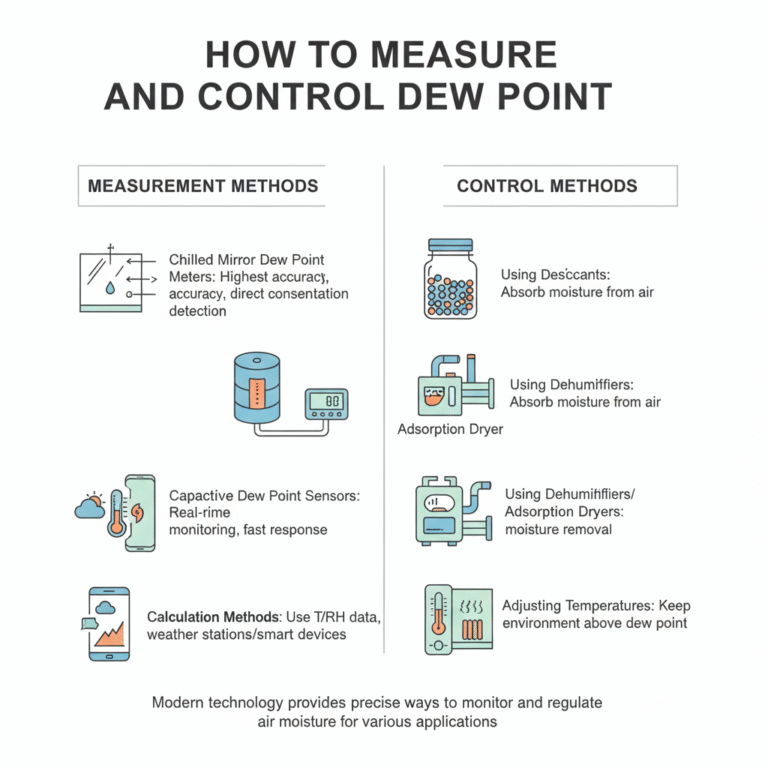What is Dew Point Temperature?
In meteorology, dew point temperature (Td) refers to the temperature at which air, while keeping the same air pressure and water vapor content, cools down enough for the water vapor to start condensing. In simple terms, it’s the moment when air becomes “saturated with water.”
When air cools down to the dew point, the water vapor in the air begins to turn into liquid water—this is the process that forms dew, fog, or frost. The dew point is usually measured in degrees Celsius (°C) or Fahrenheit (°F).

Understanding Dew Point through the “Bucket Model”
For many, the definition of dew point temperature can be hard to grasp. Let’s use a simple analogy—imagine the air as a water-filled bucket:
Warm air acts like a large bucket that can hold a lot of water molecules.
Cold air acts like a small bucket that can hold only a small amount of water.
When the bucket is full (relative humidity = 100%), the excess water overflows, forming dew or fog. For instance, imagine air at 22°C with a relative humidity of 50%. In this case, the “bucket” is half-full. If the temperature drops to 11°C, the bucket gets smaller, and now the same amount of water fills the bucket, which means the air is now saturated—this is the dew point temperature (11°C). If the temperature drops even further, the air can no longer hold the moisture, and the excess water turns into liquid or ice.

The Relationship Between Dew Point, Humidity, Temperature, and Pressure
1. Dew Point and Humidity
When the air temperature equals the dew point temperature, the relative humidity is 100%. If the temperature is higher than the dew point, the air has more room for moisture, and the relative humidity is less than 100%. The larger the difference between the temperature and dew point, the drier the air. For example:
Indoor air at 24°C with 65% humidity has a dew point of about 17°C.
Outdoor air at 29°C with 50% humidity has a dew point of about 18°C.
Despite the indoor humidity being higher, the outdoor air contains more water vapor due to the higher dew point.
2. Dew Point and Pressure
Under the same humidity, increasing pressure or humidity will raise the dew point. While atmospheric pressure doesn’t significantly affect the dew point in most cases, at high altitudes, where air pressure is lower, air cools faster, causing the dew point to drop.
3. Dew Point and Comfort
Dew point temperature not only affects the weather but also plays a major role in our comfort levels:
| Dew Point Temperature | Comfort Level |
|---|---|
| < 10°C | Dry and comfortable |
| 10–16°C | Slightly humid but comfortable |
| 16–21°C | Humid and uncomfortable |
| > 21°C | Oppressive, sweat doesn’t evaporate easily |
This is why summer in southern regions, where the dew point is higher, feels much more humid than in northern regions, despite similar temperatures.

Importance of Dew Point in Industrial Applications
Dew point temperature is not only a meteorological parameter but also a key factor in product quality, equipment safety, and production efficiency in industrial processes.
1. Compressed Air and Gas Treatment
In compressed air systems, the air is compressed and its temperature increases. If the dew point is not controlled properly, water vapor condenses into droplets during cooling, causing:
Corrosion of valves and pipelines
Malfunction of pneumatic components
Product contamination (e.g., in spraying or electronics manufacturing)
To avoid these issues, industrial systems use refrigeration dryers or adsorption dryers to lower the dew point to between -20°C and -70°C, ensuring dry gas without moisture.
2. Pharmaceutical and Food Industries
In the pharmaceutical and food packaging and storage processes, if the ambient temperature drops below the dew point, water vapor condenses on equipment or product surfaces, leading to several quality risks. For example:
Pharmaceuticals can degrade due to moisture exposure.
Food products may spoil or mold.
Powdered materials may clump due to moisture absorption, affecting production and usage.
Therefore, controlling the dew point in cleanrooms is critical for ensuring product quality and production safety.
3. Energy and Metallurgy
In gas, smelting, or thermal systems, dew point temperature control is crucial:
If exhaust temperatures fall below the dew point, water vapor will condense inside pipes or dust collectors, leading to corrosion, blockages, or even explosions.
Typically, the operating temperature is kept at least 20°C higher than the dew point to ensure system safety.
4. Electronics and Optics Manufacturing
In chip, optical instrument, and laser manufacturing, even tiny amounts of condensed water vapor can cause severe damage. For example:
Moisture on chip surfaces can damage components.
A thin layer of water on optical lenses can affect clarity and imaging accuracy.
Moisture in delicate circuits can lead to short circuits.
In these high-precision manufacturing fields, controlling the dew point is essential for ensuring product performance and reliability. As a result, these industries often require environmental dew points lower than -40°C.

How to Measure and Control Dew Point
Modern dew point measurement methods include:
Chilled mirror dew point meters: These provide the highest measurement accuracy by directly detecting the temperature at which condensation forms on a mirror surface.
Capacitive dew point sensors: These are often used for real-time monitoring in gas pipelines, offering fast response times for continuous measurement.
Calculation methods: These use temperature and humidity data to calculate the dew point temperature and are widely used in weather stations and smart devices.
Control methods include:
Using desiccants (e.g., silica gel, molecular sieves)
Using dehumidifiers or adsorption dryers
Adjusting temperatures to keep the environment above the dew point temperature

Conclusion
Though the dew point temperature may seem like a simple meteorological term, it is a critical factor that connects natural phenomena, human comfort, and industrial technology. It explains why windows fog up, why summer heat feels more oppressive in certain regions, and why controlling humidity is essential in industrial processes. By understanding the dew point, we can better control air moisture, enhance comfort, and ensure the safety and quality of industrial operations.
Mastering the dew point allows us to “read the language of the air”—it dictates humidity, comfort, and even the safety of production lines and product quality.
